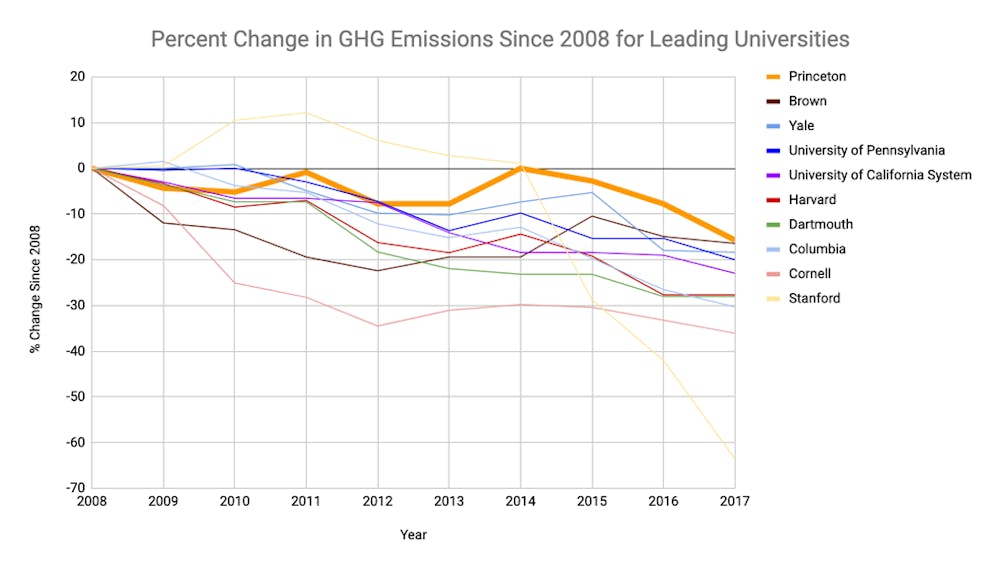As the repercussions of climate change are expected to be increasingly disruptive in the near future, universities across the country have placed larger emphases on sustainability and reducing climate emissions. To better understand how Princeton measures up against its peer institutions, members of the Princeton Student Climate Initiative (PSCI) have compiled a report analyzing over 75 institutions in the United States, evaluating a wide variety of factors, including carbon neutrality dates, greenhouse gas emissions, and usage of renewable energy sources.
Through independent research, PSCI has found that over the past decade, as leading institutions have achieved unparalleled milestones in the fight against climate change, the University has fallen behind many of the top players who have directed this widespread transition toward clean energy and net-zero emissions. In examining and emulating the notable efforts of peer universities (which we have summarized below), the University could adopt a stronger stance toward confronting the increasingly imminent threat of global warming.
Our findings reveal exceptional initiatives implemented by universities that, we believe, should be given greater recognition: In 2015, Harvard University broke records as the only higher-education institution in the world to attain over 100 LEED certified buildings. In 2019, Carnegie Mellon University purchased enough renewable energy credits, or RECs, to power 100 percent of its electricity usage. The same year, Rice University converted over 75 percent of its campus cars to electricity-powered vehicles. And by 2021, Stanford University will be 100 percent solar powered.
These feats are not just limited to private institutions. The University of Oklahoma became 100 percent wind-powered back in 2013, and in 2019, the University of California system announced plans to completely divest from fossil fuels, cutting its $80 billion portfolio from further investments in an industry that is the driving force behind climate change.
But how do Princeton’s accomplishments compare? Unfortunately, based on our comparative analyses of Princeton’s emissions reductions, carbon neutrality goals, and renewable energy sources against other universities’ efforts, we conclude that Princeton’s progress has been lagging.
We first examined the dates by which individual universities aspire to reach a net-zero carbon footprint (by balancing the amount of carbon it emits and removes), or its “commitment date” to carbon neutrality. Since carbon dioxide is the primary greenhouse gas emitted by our population, many universities have announced their target to achieve carbon neutrality in the near future. Currently, only four of the sampled colleges (Middlebury, Colgate, American, and Colby) are 100 percent carbon neutral. In 2019, Princeton announced their commitment to 100 percent carbon neutrality by 2046, the 300th anniversary of the University’s founding. Out of the eight Ivy League institutions, this date situates Princeton as the fourth-earliest commitment date. Although Princeton’s commitment goal is commendable, we must acknowledge that certain peer institutions are pushing the boundaries in reaching carbon neutrality within the next five years, including Stanford (2021), Duke (2024), and the University of California system (2025).
Looking at greenhouse gas emissions for Ivy League institutions and Stanford University from 2008 to 2017, the data reveal, fortunately, that all universities have reduced their greenhouse gas emissions over time, with Stanford leading this trend with an astounding 63.5 percent reduction. However, Princeton trails last with only a 15.7 percent reduction, an explicit indication that Princeton needs to hasten its course toward zero emissions.
The final factor we considered was university implementation of renewable energy sources, in particular solar, wind, hydroelectric, and biomass energy.

Solar energy, known for its cost-saving benefits, dependability, and most importantly, its environmental friendliness, was the most popular renewable energy source for universities across the nation. Princeton’s solar energy portfolio is surprisingly well equipped: a 27-acre solar field, providing 4.5 megawatts (MW) of energy, which results in 3100 metric tons of CO2 emissions saved per year. Construction has begun for an additional 13 MW of solar panels to be located on various parking lots and new acquisitions south of the campus. In total, the 17.5 MW of solar energy would provide for approximately 20 percent of the university’s electricity needs. These numbers dwindle in comparison to Stanford’s solar energy prowess: a mind-blowing 160 MW of solar energy by 2021, accounting for 100 percent of the university’s electricity demands (note: we do recognize that Stanford has the advantage of being situated in sunny California).
Moreover, Princeton has not yet implemented other sources of renewable energy commonly used by peer institutions, including wind, hydroelectric, and biomass energy. Further research is necessary to determine whether these three sources could be realized on Princeton’s campus.
Based on PSCI’s comparative assessment of 75 universities’ commitment dates, greenhouse gas emissions, and clean energy usage, it appears that Princeton University’s efforts in fighting climate change are neither exceptional nor inadequate. While it is clear that the University should enact further measures to accelerate their progress toward carbon neutrality as compared to peer institutions, several factors may be affecting the administration’s ability to implement alternative energy sources, such as climate, geography, and the natural abundance of resources located around the Princeton area. Many of our energy needs will possibly need to be sourced from off-campus, requiring the administration to expedite its current search for local renewable energy projects.
Princeton should also derive inspiration from the advancements of other institutions to further reduce carbon emissions. Some examples include Yale University’s carbon tax, Rice University’s all-electric campus vehicles, or Southwestern University’s subsidized public transportation. To ensure that the University remains one of the leading educational institutions in America, the administration should look toward other universities’ endeavors to bolster its own.

Shannon Heh and William Gu are both first-years and members of the Princeton Student Climate Initiative. Other members of PSCI (Karena Yan, James Porter, and Rifat Islam) also contributed to the research for this Op-ed. For more information on PSCI, please contact PSCL@princeton.edu.








